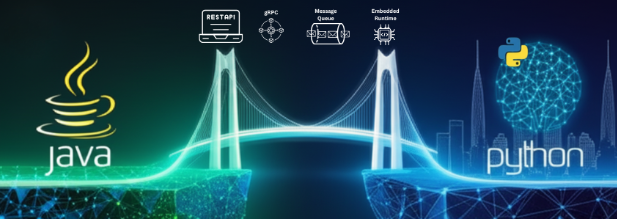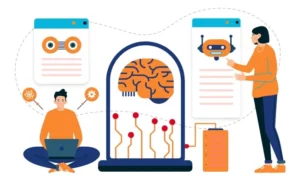Enterprises today face a unique challenge when building intelligent applications. On one hand, Java remains the backbone of large-scale, mission-critical systems due to its stability, scalability, and rich ecosystem. On the other hand, Python has become the go-to language for developing machine learning (ML) and artificial intelligence (AI) models, thanks to its powerful libraries like TensorFlow, PyTorch, and scikit-learn. The need to bridge the gap between these two languages is more urgent than ever.
Java developers want to harness the predictive power of Python-based AI models without abandoning their existing infrastructure. But connecting these two worlds is not straightforward. Differences in language runtime, data serialization, and resource management make integration complex. That’s why it’s crucial to explore and understand the available methods for Java-to-Python communication—each with its strengths and trade-offs.
This article offers a pragmatic look into the most viable methods for integrating Python AI/ML models into Java enterprise applications. By the end, you’ll have a clear understanding of which integration method suits your project’s goals, scalability requirements, and maintenance budget.
Key Takeaways
- REST APIs: Easiest to implement and maintain; best for non-real-time tasks where latency isn’t critical.
- gRPC: Ideal for high-performance, low-latency communication between internal microservices.
- Message Queues: Perfect for asynchronous, decoupled workflows that require fault tolerance and scalability.
- Embedded Runtimes (GraalVM): Offers the tightest integration but comes with the highest complexity and potential compatibility issues.
Using REST APIs to Bridge Java and Python
One of the simplest and most widely adopted methods of integrating Python-based AI/ML models into Java systems is through REST APIs. The idea is straightforward: you deploy your Python model as a web service, usually using frameworks like Flask, FastAPI, or Django. The Java application then sends HTTP requests to this service and receives predictions or processed results in return.
Why REST is Popular: Loose Coupling and Interoperability
This method is popular for good reasons. First, it promotes loose coupling. Your Python model becomes a black-box microservice that can be scaled, monitored, and maintained independently. Second, it’s technology-agnostic. Any system that can make HTTP requests can interact with your model, making it highly interoperable.
The Downside: Latency and Security
However, REST APIs are not perfect. The primary concern is latency. HTTP is a relatively heavy protocol, and if your application needs to make real-time predictions at high volume, REST might not keep up. Serialization and deserialization of JSON, while flexible, adds additional overhead.
Security is another factor. Exposing your model as a service requires attention to authentication, authorization, and encryption, especially in enterprise environments. Proper endpoint hardening and rate-limiting are essential to prevent abuse or data leakage.
In summary, REST APIs are best suited for applications where ease of use and maintainability matter more than ultra-low latency. For batch processing or user-facing apps where milliseconds don’t break the UX, REST is a solid starting point.
Leveraging gRPC for High-Performance Communication
When performance becomes a bottleneck, gRPC (Google Remote Procedure Call) offers a more efficient alternative to REST APIs. Unlike REST, which uses JSON over HTTP, gRPC uses Protocol Buffers over HTTP/2, providing a more compact and faster messaging format.
gRPC shines in situations where speed and efficiency are critical. For example, in financial services, fraud detection models may need to score thousands of transactions per second. In such cases, gRPC outperforms REST by reducing serialization time and network payload size. The persistent connection of HTTP/2 also enables multiplexing, reducing latency for concurrent requests.
Another major benefit of gRPC is strong typing. With REST, there’s always a risk of schema mismatches unless you use additional tooling. gRPC defines contracts through .proto files, ensuring both client and server agree on data formats.
But gRPC also has its challenges. It’s more complex to set up compared to REST, especially in environments unfamiliar with Protocol Buffers. Also, browser support is limited unless you introduce an API gateway that can translate gRPC calls into REST or WebSocket protocols.
Despite these complexities, gRPC is an excellent choice for internal microservices where performance and scalability are key. It’s particularly well-suited for real-time AI systems, such as recommendation engines or supply chain optimizers, that rely on fast, structured communication between Java and Python services.
Using Message Queues for Asynchronous Workflows
In many enterprise scenarios, AI/ML inference doesn’t need to happen instantly. For example, nightly data analysis, document classification, or background risk scoring can tolerate a slight delay. In such cases, using a message queue system like RabbitMQ, Apache Kafka, or AWS SQS can be a smart integration strategy.
Here, the Java application sends a message (e.g., a customer profile or transaction log) to a queue. A Python worker listening to that queue picks up the message, runs the AI model, and pushes the result back to another queue or database. This decouples the producer (Java) and consumer (Python), allowing each to scale independently.
One of the biggest advantages of message queues is fault tolerance. If the Python model crashes or needs a restart, the messages remain in the queue and are processed once the worker is back online. This makes it ideal for batch jobs and workflows that can tolerate some latency.
Another benefit is scalability. You can spin up multiple Python workers to handle a surge in demand without touching the Java codebase. Plus, queues naturally provide load-leveling capabilities.
However, asynchronous messaging comes with trade-offs. Implementing reliable delivery, message deduplication, and eventual consistency requires careful architectural planning. Debugging can also be more complex due to the distributed nature of the system.
Still, for use cases involving data pipelines, offline predictions, or event-driven architecture, message queues provide a robust and flexible solution for Java-Python integration.
Embedding Python Runtimes in Java Using Jython and GraalVM
For tight integration and minimal latency, embedding a Python runtime directly into the Java application may seem appealing. Options like Jython and GraalVM enable this approach, allowing Java code to directly invoke Python functions and share memory space.
Jython, a long-standing implementation of Python for the JVM, is largely a legacy option as it only supports Python 2.7, which lacks compatibility with modern ML libraries.
The more modern approach is GraalVM, a polyglot virtual machine that supports running multiple languages. While this sounds ideal, it’s crucial to understand that the GraalVM Python runtime is still evolving. Critical machine learning libraries may have compatibility gaps, and performance can be unpredictable. This approach carries the highest risk and should be reserved for teams with deep expertise who can manage the compatibility challenges.
Embedded runtimes are best suited for applications requiring tight coupling between logic layers, such as embedded systems or small-scale tools where infrastructure complexity must be minimized. In general, this powerful method should only be used when other options introduce unacceptable overhead.
Choosing Your Path: A Summary of Trade-offs
Choosing the right integration approach isn’t just about technology—it’s about balancing performance, maintainability, team skills, and cost.
|
Method |
Performance |
Complexity |
Best For… |
Key Challenge |
|
REST API |
Moderate |
Low |
Web apps, batch jobs, simple integrations |
Latency, JSON overhead |
|
gRPC |
High |
Medium |
Real-time microservices, high-throughput systems |
Setup complexity, browser support |
|
Message Queue |
Asynchronous |
Medium-High |
Decoupled workflows, fault-tolerant tasks |
Architectural overhead, not for real-time |
|
Embedded Runtime |
Very High |
High |
Tightly coupled logic, minimizing infrastructure |
Compatibility risk, resource management |
Don’t forget about team skill sets. If your developers are experienced in web APIs, REST or gRPC will be more manageable. If they’re familiar with distributed systems, message queues might be ideal. Embedding runtimes will likely require advanced JVM knowledge.
Ultimately, the “best” method depends on your specific use case. A customer-facing web app using recommendation models may benefit from gRPC. A financial compliance tool running batch risk scoring could use a message queue. A desktop tool with a lightweight embedded AI model might try GraalVM.
Conclusion
Integrating Python-based AI/ML models into Java enterprise ecosystems is no longer a nice-to-have—it’s a competitive necessity. From simple REST APIs to high-performance gRPC, from asynchronous message queues to advanced runtime embedding, each integration method brings its own benefits and limitations. The key is to assess your needs pragmatically.
There’s no one-size-fits-all solution. But by understanding the core integration patterns outlined in this guide, your development team can build smarter, faster, and more maintainable systems—where the best of Python’s AI power meets the solid foundation of Java enterprise architecture.
Hands-On Demo Project
For a practical, hands-on implementation of the concepts discussed in this article, you can explore the author’s complete demo project on GitHub: java-python-ml-demo.
Let your use case dictate your integration path—and your architecture will thank you in the long run.
About the Author
John Krupavaram Pole Bhakthavatsalam is a dynamic Senior Lead Software Engineer with a rich background of over 14 years in crafting impactful solutions using Java/J2EE and C# .NET. Currently, as a Senior Lead Software Developer at NYS IES, John is at the forefront of human-centric development, architecting critical welfare program solutions that modernize New York State’s health and human services. His expertise encompasses microservices, Spring Boot, API development, Mule ESB, and cloud deployment, navigating the full Software Development Life Cycle (SDLC) with Agile and Waterfall methodologies.
An internationally recognized expert and a distinguished IEEE Senior Member, John is known for pioneering developer efficiency through machine learning. He has played critical leadership roles in mission-driven IT projects and mentored over 20 professionals. A curious and forward-thinking developer, he serves as a Hackathon Judge, IEEE Conference Session Chair, and peer reviewer for reputed journals. John holds a Master’s in Computer Science from Kent State University and continues to shape the future of intelligent software engineering on a global scale.



































